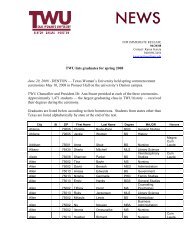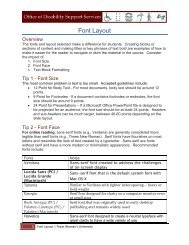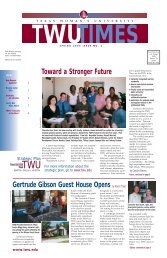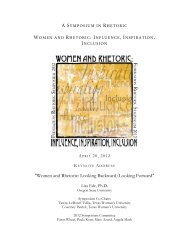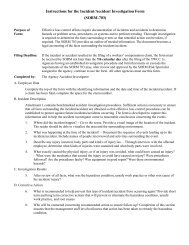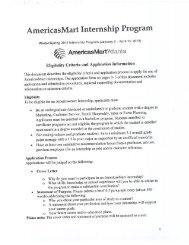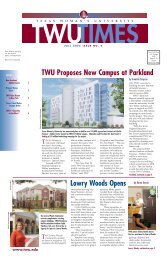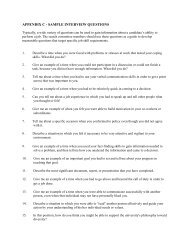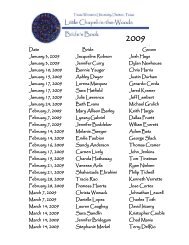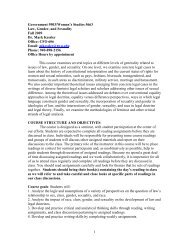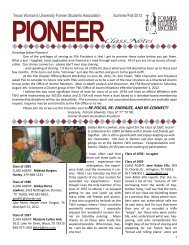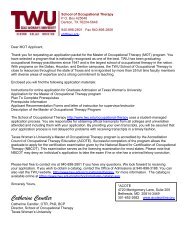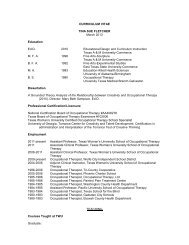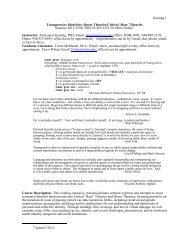SANDRA L. WESTMORELAND, Ph. D. - Texas Woman's University
SANDRA L. WESTMORELAND, Ph. D. - Texas Woman's University
SANDRA L. WESTMORELAND, Ph. D. - Texas Woman's University
You also want an ePaper? Increase the reach of your titles
YUMPU automatically turns print PDFs into web optimized ePapers that Google loves.
<strong>SANDRA</strong> L. <strong>WESTMORELAND</strong>, <strong>Ph</strong>. D.<br />
<strong>Texas</strong> Woman’s <strong>University</strong><br />
Department of Biology<br />
Box 425799<br />
Denton, <strong>Texas</strong>76204-5799<br />
Work Telephone (940) 898-2560<br />
Email: swestmoreland@twu.edu<br />
EDUCATION<br />
<strong>Ph</strong>.D. in Quantitative Biology, <strong>University</strong> of <strong>Texas</strong> at Arlington 2001<br />
M.S. in Biology, <strong>University</strong> of <strong>Texas</strong> at Arlington 1997<br />
B.S. in Biology, <strong>University</strong> of Houston 1972<br />
TEACHING EXPERIENCE<br />
Assistant Professor, Department of Biology, <strong>Texas</strong> Woman’s <strong>University</strong> 2008<br />
Principles of Biology<br />
o This course involves the development of current concepts in cell structure and<br />
functions with introduction to the organism level. This course is for science<br />
majors and minors.<br />
Teacher Education Program Advisor<br />
Lecturer, <strong>University</strong> of <strong>Texas</strong> at Arlington 2001-2008<br />
Scientific and Technical Writing<br />
o This course involves the study and application of the written and verbal<br />
communication skills involved in gathering, analyzing, and distributing<br />
scientific and technical information efficiently and accurately for specific<br />
scientific audiences.<br />
o 30 junior and senior level students per class<br />
• Cellular and Molecular Biology<br />
o The first of a three-part introductory biology sequence, this course focuses on<br />
the chemical and molecular basis of life, including metabolism, cell structure<br />
and function, and genetics.<br />
o Up to 300 freshman students per class<br />
• Structure and Function of Organisms<br />
o This course involves the study of structure and function in plants and animals.<br />
Topics include structure at the level of the cell, tissue, organ and individual<br />
growth, transport/circulation/gas exchange, nutrition, reproduction,<br />
development, endocrinology, and animal neural regulation<br />
o 150 freshman students<br />
• Introduction to Biology<br />
o This course focuses on fundamental principles, concepts, and topical subjects<br />
relating to biology. This course is for non-science majors and satisfies in part<br />
the laboratory science requirements for students in the Colleges of Liberal<br />
Arts and Business Administration, and in the School of Social Work.<br />
o 150 students, classifications vary<br />
• Human Anatomy and <strong>Ph</strong>ysiology<br />
o In this course concentrates on functional morphology of humans, cellular<br />
function, principles of support and movement, and neural and endocrine
Westmoreland<br />
Page 2<br />
control systems. This class is designed for students in sport activities, medical<br />
technology, and pre-nursing.<br />
o 150 sophomore or junior students<br />
• Medical Terminology<br />
o This course focuses on the vocabulary used to describe such things as parts of<br />
the body, locations in the body, bodily functions, diseases, surgical and<br />
clinical procedures, measurements, and medical instruments.<br />
o Distance Education course<br />
o Up to 350 students per semester, classification varies<br />
• Independent Research<br />
o Independent study by individual students in biology under the supervision of a<br />
biology faculty member.<br />
o Development of research skills using scanning electron microscopy, image<br />
analysis, collection and analysis of data, and the oral and written presentation<br />
of research results at a professional meeting.<br />
• Instructional Techniques in Biology<br />
o Students participate in lecture and/or lab sessions under the supervision of a<br />
faculty member.<br />
o Students assist in developing new teaching materials and teaching strategies.<br />
o Students present a lesson to the class.<br />
• Cellular and Molecular Biology Lab Supervisor<br />
o Labs emphasize data collection and analysis using computer programs and<br />
training in the use of spectrophotometry and gel electrophoresis.<br />
o Supervised up to 29 lab sections with 800 students.<br />
o Trained, organized, and motivated up to 10 graduate teaching assistants.<br />
o Recruited, organized, trained, and motivated up to 15 undergraduate teaching<br />
assistants.<br />
• Introduction to Biology Lab Supervisor<br />
o Supervised up to 7 lab sections with 200 students.<br />
o Trained, organized, and motivated up to 5 graduate teaching assistants.<br />
o Recruited, organized, trained, and motivated up to 10 undergraduate teaching<br />
assistants<br />
Graduate Teaching Assistant, <strong>University</strong> of <strong>Texas</strong> at Arlington 1995-2000<br />
• Human Anatomy and <strong>Ph</strong>ysiology I and II Lab Instructor and Lab Coordinator<br />
o Student laboratory exercises involve both anatomical and experimental<br />
aspects of principles introduced in the lecture.<br />
o Supervised up to 10 lab sections with 300 students.<br />
o Trained, organized, and motivated up to 6 graduate teaching assistants.<br />
o Recruited, organized, trained, and motivated up to 10 undergraduate teaching<br />
assistants
Westmoreland<br />
Page 3<br />
SECONDARY TEACHING EXPERIENCE<br />
Lifetime <strong>Texas</strong> Teacher Certification: Secondary Biology and Chemistry (Grades 6-12)<br />
Classroom Instructor, Irving High School 1976<br />
• <strong>Ph</strong>ysical Science<br />
Department Chairman and Classroom Instructor, Huffman High School 1972<br />
• Biology<br />
• Chemistry<br />
• Environmental Science<br />
• Oceanography<br />
• Algebra<br />
HONORS AND AWARDS<br />
• Outstanding Faculty Award: McNair Scholars Program 2008<br />
• Recipient of Provost’s Award for Excellence in Teaching 2006<br />
• Outstanding Teacher Award by Freshman Leaders on Campus 2006-8<br />
• Supervising Professor Fellowship, Louis Stokes Alliance for Minority<br />
Participation (LSAMP) program, Sponsored by the National Science<br />
Foundation (three awards) 2005-8<br />
• U.S. Department of Agriculture Research Grant 2005-7<br />
• Invited speaker at Poultry Science Assn. Annual Meeting 2002-8<br />
• Outstanding Student Speaker, <strong>Texas</strong> Society of Microscopy 1997<br />
• T.E. Kennerly Award for Outstanding Teaching 1998<br />
• Award for Academic Excellence, <strong>University</strong> of <strong>Texas</strong> Arlington 1998-2001<br />
SERVICE APPOINTMENTS AND ADVANCED TRAINING<br />
• Invited Participant Process Oriented Inquiry Guided Learning (POGIL)<br />
National Meeting, Arlington, <strong>Texas</strong> 2008<br />
• Panel Participant: Active Learning for Critical Thinking 2008<br />
• Teacher Certification Advisor for Department of Biology 2007-8<br />
• Faculty Liaison for Advanced Placement Biology Training Workshop 2007-8<br />
• Member Undergraduate Curriculum Committee 2007-8<br />
• Member of One Book Selection Committee 2007-8<br />
• Member Teacher Education Committee 2006-8<br />
• Facilitator of Active Learning Faculty Teaching Circle<br />
(appointment by the Provost) 2007-8<br />
• Participant Process Oriented Inquiry Guided Learning Workshop<br />
(POGIL) at Washington <strong>University</strong>, St. Louis, Missouri 2007<br />
• Participant Science Education for New Civic Engagement and<br />
Responsibilities (SENCER) Workshop at The <strong>University</strong> of Southern<br />
Maine, Portland, Maine 2007<br />
• Participant Next Generation Course Redesign Workshop at The<br />
<strong>University</strong> of North <strong>Texas</strong>, Denton, <strong>Texas</strong> 2007<br />
• Member McNair Selection Committee 2006-8<br />
• Member of Honors College Faculty 2006-8<br />
• Supervising Professor for Honor’s Thesis 2006-8
• Participant Active Learning Training Seminars 2006-8<br />
• Conducted McNair Scholars Writing Workshop 2005-8<br />
• Member Health Care Professionals Advisory Committee 2005-8<br />
• Member Science Technology Engineering and Math Committee<br />
• for Gender Equity 2006-8<br />
• Participant Tissue Engineering Conference at Rice <strong>University</strong> 2006<br />
PROFESSIONAL MEMBERSHIPS<br />
• National Science Teachers Association 2008<br />
• National Association of Research for Science Teachers 2008<br />
• <strong>Texas</strong> Society of Microscopy 1996-present<br />
o Program Chairman (2008-9)<br />
o President (2005-6)<br />
o Secretary (2000-2)<br />
• Poultry Science Association 2002-present<br />
• Microscopy Society of America 1996-present<br />
• <strong>Ph</strong>i Sigma Graduate Honor Society 1996-present<br />
Westmoreland<br />
Page 4<br />
FUNDED RESEARCH<br />
• Principle Investigator for POGIL SPUR Research Proposal: Title: BIO-POGIL:<br />
It's alive! (submitted August 2008)<br />
• Author and Principle Investigator for POGIL SPUR Research Proposal: Using<br />
Process Oriented Guided Learning (POGIL) in the Large Biology Classroom (not<br />
funded submitted 9/15/07)<br />
• “Microscopic evaluation of egg membrane and shell structure for effects of diet<br />
and F-strain Mycoplasma gallisepticum (FMG) when administered to commercial<br />
layers (Hyline W36)” in cooperation with Dr. David Peebles, et al., Department of<br />
Poultry Science Mississippi State <strong>University</strong>. Funded by a grant from the U.S.<br />
Department of Agriculture.<br />
• “The effects of post-hatch estrogen on eggshell quality of zebra finches” in<br />
cooperation with Dr. Jim Millam, <strong>University</strong> of California, Davis. Funded by a<br />
grant from the National Science Foundation.<br />
RESEARCH<br />
• “The effect of space flight on calcium uptake from eggshell of Japanese quail” in<br />
cooperation with Dr. Patricia Hester, Department of Poultry Science, Purdue<br />
<strong>University</strong> and National Aeronautics and Space Administration.<br />
PUBLISHED ABSTRACTS AND PLATFORM PRESENTATIONS:<br />
S.L. Westmoreland*1, H.Pourarsalan1, K. A. Schug3, and J. R. Millam2, 1Department of<br />
Biology, <strong>University</strong> of <strong>Texas</strong>, Arlington, 2Department of Animal Science, <strong>University</strong> of<br />
California, Davis, 3Department of Chemistry, <strong>University</strong> of <strong>Texas</strong>, Arlington. 2008.<br />
Investigating the effects of estrogen on Zebra Finch eggshell thickness and eggshell<br />
morphology. Poultry Science. 87(Supplement 1): 18.
Westmoreland<br />
Page 5<br />
Westmoreland SL. Pourarsalan H. Schug K Millam J. 2008. Examining the Morphology<br />
of Different Effects of Estrogen on Zebra Finch Eggshell Thickness. <strong>Texas</strong> Journal of<br />
Microscopy. <strong>Texas</strong> Journal of Microscopy. 38(2):128.<br />
Westmoreland SL, Pourarsalan H, Hawkins DL, Rochester JR, Millam JR. 2007.<br />
Changes in Zebra Finch (Taeniopygia guttata) Eggshell Morphology after Oral Estrogen<br />
Exposure as Chicks. Journal of Poultry Science. 86(2007):Supplement 1.<br />
Pourarsalan H, Gracey M, Westmoreland SL. 2007. Investigating the Different Methods<br />
of Eggshell Thickness Measurements: A comparison of Microcaliper and Image<br />
Analysis. <strong>Texas</strong> Journal of Microscopy. 38(1):10.<br />
Westmoreland SL, Pourarsalan H, Hawkins DL, Rochester JR, Millam JR. 2006. The Use<br />
of Scanning Electron Microscopy and Image Analysis to Determine Changes in Zebra<br />
Finch (Taeniopygia guttata) Eggshell Morphology after Oral estrogen Exposure as<br />
Chicks. <strong>Texas</strong> Journal of Microscopy. 38(1):10.<br />
Westmoreland SL, May SB, Gracey MI, Hawkins DL, Peebles ED, Park SW, Branton<br />
SL. 2006. Determination of Eggshell Microstructural Characteristics and Associated<br />
<strong>Ph</strong>ysiological Profiles in MG-Vaccinated Egg-Laying Chickens. Poultry Science<br />
Association 95th Annual Meeting Abstracts. 85 (Supplement 1):1-227.<br />
Westmoreland SL, Halupnik T, Walker J, and Hester PY. 2005. Microgravity’s Effect on<br />
Mammillary Cones of Japanese Quail Eggs. <strong>Texas</strong> Journal of Microscopy. 36(1):14.<br />
Westmoreland S. Halupnik T. Walker J. Hester P. 2005. Effect of Microgravity on<br />
Mammillary cones of Japanese Quail Eggs. Poultry Science Proceedings from the 94 th<br />
Annual Meeting. 84(Supplement 1):1-152.<br />
Emam H, Haifa J, Luna C, Shah K, Woehrle S, and Westmoreland S. 2004. The Effects<br />
of Estradiol Benzoate on the Thinning of Zebra Finch Eggshells. <strong>Texas</strong> Journal of<br />
Microscopy. 35(1).<br />
Rahmani S. and Westmoreland S. 2004. Electron Microscopy Analysis of Gentoo<br />
Penguin Eggshells. <strong>Texas</strong> Journal of Microscopy. 35(1).<br />
Westmoreland S. Hester P. Halupnik T. 2004. Changes in eggshell of Japanese quail<br />
during embryogenesis. Poultry Science Proceedings from the 93 rd Annual Meeting. 83<br />
(Supplement 1).<br />
Westmoreland S, Halupnik T, and Hester P. 2004. Changes in Eggshell of Japanese Quail<br />
During Embryogenesis. <strong>Texas</strong> Journal of Microscopy. 35(2).<br />
Westmoreland SL. 2003. Comparative Study of Examination Techniques for Imaging<br />
Avian Eggshell. Proceedings of Microscopy and Microanalysis. 9(2):1520CD.<br />
Westmoreland SL. 2003. A Comparison of Pore Size in Avian Eggshells Measured Using<br />
Three Methods: Water Vapor Gas Conductance, Computer Image Analysis, and
Westmoreland<br />
Page 6<br />
Vitalscan. Poultry Science Association 92nd Annual Meeting Abstracts. 82 (Supplement<br />
1):1-156.<br />
Westmoreland SL. 2003. A Comparative Study of Examination Techniques for Imaging<br />
Avian Eggshell. <strong>Texas</strong> Journal of Microscopy 34(2):13.<br />
Westmoreland SL. 2002 A Study of Casts from Epoxy Embedded Eggshell of White<br />
Leghorn Chickens. Poultry Science Association Proceedings from the 91st Annual<br />
Meeting. 81 (Supplement 1).<br />
Westmoreland SL. 2002 A Study of Casts from Epoxy Embedded Eggshell of White<br />
Leghorn Chickens. <strong>Texas</strong> Journal of Microscopy. 34(1).<br />
Westmoreland SL and Arnott HJ. 2001. Estimation of Eggshell Pore Size Using the<br />
Method of Water Vapor Gas Conductance. <strong>Texas</strong> Journal of Microscopy. 32(2):19.<br />
Westmoreland SL and Arnott HJ. 2001 Using the Internet to Organize Teaching<br />
Materials. <strong>Texas</strong> Journal of Microscopy. 32(2):24.<br />
Westmoreland SL and Arnott HJ. 2000. Sources of Variation in Pore Density in<br />
Eggshells of White Leghorn Chickens. <strong>Texas</strong> Journal of Microscopy. 31(1):41.<br />
Westmoreland SL and Arnott HJ. 1999. a Comparison of the Mammillary Cone Region<br />
of the Eggshell of the Domestic Fowl as Observed in Thick (30-micron) and Thin (1-<br />
micron) Embedded Samples Using Light Microscopy. <strong>Texas</strong> Journal of Microscopy.<br />
30(2):44.<br />
Westmoreland SL and Arnott HJ. 1999 Structural Changes in White Leghorn Eggshells<br />
after Treatment with Buffered Solutions from pH 6.6 to pH 7.6. <strong>Texas</strong> Journal of<br />
Microscopy. 30(1):9.<br />
Westmoreland SL and Arnott HJ. 1998 Structural Changes in Eggshells Due to<br />
Treatment with Buffered Aqueous Solutions Ranging From pH 6to 8. <strong>Texas</strong> Journal of<br />
Microscopy. 29(2):46.<br />
Westmoreland SL and Arnott HJ. 1998. A Comparison of Untreated Mammillary Cones<br />
of Incubated Eggs of the Domestic Fowl with Those Treated with sodium Hypochlorite<br />
for Protein Removal. <strong>Texas</strong> Journal of Microscopy. 29(1):9.<br />
Westmoreland SL and Arnott HJ. 1997 Changes in Mammillary Cones During Incubation<br />
of Fertilized Eggs of Gallus domesticus. <strong>Texas</strong> Journal of Microscopy. 28(2)44.<br />
Westmoreland SL and Arnott HJ. 1997 A Comparison of Mammillary Cones of<br />
Incubated and Non-incubated Avian Eggs. <strong>Texas</strong> Journal of Microscopy. 28(1):12.<br />
Westmoreland SL and Arnott HJ. 1996. A Comparison of Modern Avian and Fossilized<br />
Avian Eggshell Microstructure. <strong>Texas</strong> Journal of Microscopy. 27(2):44.
Westmoreland<br />
Page 7<br />
POSTER PRESENTATIONS:<br />
Westmoreland SL. 2008. The Use of Technology to Facilitate Active Learning and<br />
Student Success in the Large Biology Classroom. National Meeting of Process Oriented<br />
Inquiry Guided Learning (POGIL), Arlington, <strong>Texas</strong>.<br />
Westmoreland SL. 2002. A Study of Casts from Epoxy Embedded Eggshell of White<br />
Leghorn Chickens. Gordon Research Conference on Biomineralization.<br />
Westmoreland SL and Arnott HJ. 2000. Variation of Pore Density in Chicken Eggshells.<br />
Gordon Research Conference on Biomineralization.<br />
Westmoreland SL and Arnott HJ. 1998. Complementary Fracture Faces in Caps and<br />
Cones of Incubated Eggshell of White Leghorn Chickens. Gordon Research Conference<br />
on Biomineralization.



